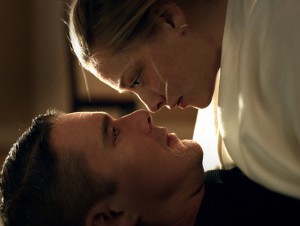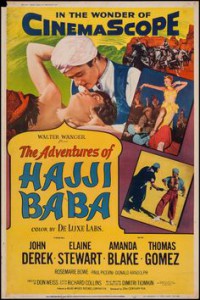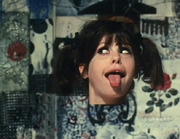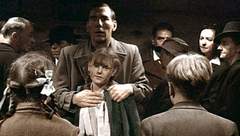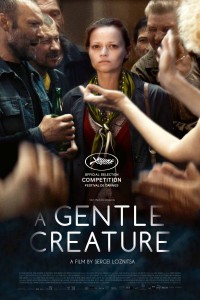From the Winter 2019 issue of Cinema Scope. — J.R.
Since I don’t have much investment in parsing Arnaud Desplechin’s arsenal of “personal” references, I had to look elsewhere for the intermittent pleasures of Ismaël’s Ghosts (2017), available on a two-disc Blu-ray from Arrow Films. I often find myself so hard put to navigate Desplechin’s multiple allusions to and borrowings from Philip Roth and Woody Allen (for me, the most overrated and least interesting members of his overstuffed pantheon), much less those from James Joyce, Alfred Hitchcock, Norman Mailer, and Alain Resnais, that I have to forsake any sustained effort to rationalize how these and countless other figures could all belong to the same curious tribe of role models. Maybe this is because Desplechin appears to regard these touchstones as sacred talismans more than as meaningful or helpful artistic influences. Apart from naming László Szabó and Louis Garrel’s characters “Bloom” and “Dedalus,” respectively, it’s difficult to determine how much he’s actually learned or adapted from Ulysses—and when he combines nods to both Ulysses and Vertigo (1958) in the name of Marion Cotillard’s character “Carlotta Bloom,” the whole thing begins to seem like the silliest kind of fool’s game. As for Ismaël himself (Mathieu Amalric), is his name supposed to start us thinking about Moby-Dick, the Bible, or maybe both? Frankly, I don’t know and I don’t care.
The two discs are devoted to the 114-minute theatrical version and the 135-minute director’s cut. I watched both, in that order, but had to wait 70 minutes in the latter before I encountered any new material: a sequence explicating yet another Desplechinian reference, according to which Szabó’s Bloom is actually a stand-in for Claude Lanzmann. Otherwise, the longer version is somewhat more coherent (although it doesn’t clarify or justify some of the story’s sketchier side-plots, such as those involving the hero’s adopted son or the heroine’s disabled brother), and in both versions most of the film’s kicks are to be found in the storytelling, stylistic flourishes (when it comes to superimpositions and reverse angles), and acting (Charlotte Gainsbourg is especially resourceful). None of these virtues, however, are aided by Desplechin’s proud parading of his assorted influences and inspirations. Desplechin does his film no favours when he speaks of his indebtedness to Resnais’ Providence (1977) in a video interview included as an extra: it’s the sort of reference point that can only make his film seem feeble by comparison, yet he trots it out like a badge of honour.
By the same token, when I try to fathom Paul Schrader’s uses of Robert Bresson in First Reformed (2017, available on a Blu-ray from Lionsgate) — a much more ambitious and substantial film than Ismaël’s Ghosts, and probably even Schrader’s best film to date (though still much inferior to anything by Bresson) — I have to remind myself that masters and masterworks are notable for what they choose not to do as well as for what they actually accomplish. Bresson’s use of his own influences, even when they extended to borrowing portions of Crime and Punishment for Pickpocket (1959), never stooped to borrowing stray narrative details from his most favoured movies just to “prove” his enduring reverence for them. I can’t see how the character of Reverend Ernst Toller (beautifully incarnated by Ethan Hawke) in First Reformed is enhanced or illuminated in any way by having him consume alcohol like the priest in Bresson’s Journal d’un curé de campagne (1951), or preach to a nearly empty church as the hero does in Bergman’s Winter Light (1963), or outfitting him with some of the same kinds of craziness assigned to Robert De Niro’s Travis Bickle in Taxi Driver (1976), for which Schrader wrote the screenplay.
Even though Schrader was born in 1946 (making him only three years younger than me) and Desplechin in 1960, I would argue that they’re both Movie Brats belonging to the same generation—at least when it comes to their philosophy of citation, which often comes closer to superstition than any form of artistry, and is apparently motivated by an inferiority complex when it comes to the riches yielded by 1960s cinephilia. In contrast to Schrader, Desplechin, and other filmmakers of similar persuasion — including Peter Bogdanovich (born four years ahead of me), Brian De Palma (three years my senior), and Martin Scorsese (born only three months earlier), as well as Quentin Tarantino (born 20 years later) and Paul Thomas Anderson (27 years later) — I would label myself a French New Waver who regards the citations of Godard, Resnais, and Rivette as critical notations that change my perceptions of the works in question, not merely as stamps of approval.
A key difference between Schrader’s film and Desplechin’s is that First Reformed is trying to say something serious about the real world today (a fairly uncommon undertaking), whereas the “real,” present-day settings of Ismaël’s Ghosts are far more dependent on the world of movies and movie conventions. (Perhaps the strongest link between these films can be found in the powerful performances of their respective lead actors, Hawke and Amalric, each at his peak or near-peak when playing crazed and tormented individuals.) I’m also fairly sure that Schrader, having cited Jean-Paul Sartre’s Nausea as one of his inspirations for Taxi Driver, must also understand that trying to conflate the issues of Nausea with the dilemmas of Bickle—or, for that matter, the issues or dilemmas of John Wayne’s Ethan Edwards in The Searchers (1956), another avowed Schrader influence — is a gesture that any existentialist would recognize as one of bad faith. I also assume it’s equally obvious to him that neither Bernanos nor Bresson (nor John Ford, for that matter) would ever employ an “homage” of the sort that he routinely traffics in. On the other hand, if we concede that Schrader’s admiration of Bernanos, Bresson, and Ford must be every bit as genuine as the general public’s admiration of Taxi Driver, then Schrader’s bad-faith desire to reconcile all of them artistically is understandable from a human as well as a commercial standpoint, even if it remains highly questionable as a philosophical, aesthetic, or moral undertaking — one which might be considered roughly parallel to attempting to fuse the disparate spiritual quests of, say, Fyodor Dostoevsky and Mickey Spillane. (Admittedly, Spillane’s prose doesn’t exude the sort of irony implied in the public celebration of Bickle as a mass murderer in the coda of Taxi Driver, but I’m also not persuaded that Schrader’s irony was, or is, perceived as such by most of his public. And it’s worth adding that, deliberately or not, the racism of both Bickle and Edwards is represented in a manner that encourages a certain amount of audience identification.)
On the other hand, I have to admit that some portions of First Reformed and virtually all of Ismaël’s Ghosts consist of movie hokum, and hokum has a lot to do with what I like about them — for instance, the vaguely psychedelic fantasy excursion in Schrader’s film where Toller and his beloved levitate and then float serenely across the heavens. I initially assumed this to be the most original sequence in the film, a scene that, for once, wasn’t predicated on Schrader tipping his hat to some other film and sequence — until Schrader, in his audio commentary, dutifully ticked off such typically incompatible touchstones as The Thomas Crown Affair (1968), two Tarkovsky films, and Koyaanisqatsi (1982) as the inspirations for three separate parts of it, which suggests that maybe he needs to think he’s copying something in order to be inventive. (A little later, he informs us that Toller wrapping barbed wire around his chest was suggested by Hazel Motes in Flannery O’Connor’s Wise Blood — the novel, not the movie. The fact that Toller is usually an intelligent, thoughtful, and sane individual and Motes is virtually always a crazed and stupid oaf is presumably less important than their shared spiritual grief.) Whatever Schrader’s motivations, his forcing me to think of both Hitchcock and De Palma as the camera endlessly circles the embracing couple in the film’s emotional climax mostly diminishes my engagement with his own story and characters. How could it not when he keeps plastering me with all these compulsive replays of Golden Oldies? But perversely, and improbably, Schrader reveals in the same audio commentary that his own reference point for this ending was Carl Dreyer’s Ordet (1955) — and apparently not even that film’s own 360-degree dolly, but its final romantic clinch and its theme of resurrection. Presumably, by this time, dollying interminably around a kissing/ embracing couple as in Vertigo and/or De Palma’s Obsession (1976) has become for Schrader less a particular movie reference or a cliché than an ordinary piece of everyday grammar, or perhaps just a Pavolvian signal for heavy emotion.
What is cinema’s greatest use of a compulsively repeated theme song? Some would probably pick High Noon (1952), but I might opt for Don Weis’ The Adventures of Hajji Baba two years later (which employed the same musical director, Dimitri Tiomkin) — even though its use of an echo chamber was likely prompted by the earlier movie. More generally, for sheer, enjoyable movieness I can think of few other examples from ’50s Hollywood (apart from Weis’ own 1953 I Love Melvin) more precious than this sexy CinemaScope romp, which is far too good to qualify as camp, so I’m delighted that Twilight Time has just released it on Blu-ray. I owe my rediscovery of this singular jewel to French criticism, which has never been embarrassed to embrace pleasure wherever it can find it.
***
It’s great to have Olive Films’ Blu-ray of Don Siegel’s Invasion of the Body Snatchers (1956), in which stars Kevin McCarthy and Dana Wynter, Siegel’s son, Joe Dante, and Larry Cohen, among others, all participate in the multiple and multifaceted extras — even if Joe seems to think that Jack Finney, author of the movie’s source novel, and Charles Finney, author of The Circus of Dr. Lao, are the same person (or so he seems to mutter in an aside). But no matter: there’s enough supplementary material here to stock a dissertation about the movie, and a good one at that.
***
Facets’ no-frills DVD of Luis Buñuel’s A Woman Without Love (1952) allowed me to catch up with the Mexican feature that most commentators, including Buñuel, seem to regard as his worst film. What this means, at least from an auteurist standpoint, is that it’s Buñuel at his least Buñuelian; as a well-stocked, glitzy Mexican melodrama, however (which may qualify it as Buñuel at his most Mexican), it’s serviceable enough and held my interest. Its source is reportedly not so much Guy de Maupassant’s 1888 novel Pierre et Jean as its successful 1943 film adaptation by André Cayette, although whether it’s mostly a shot-by-shot remake (as Buñuel claims in a book-length interview) or a deviation from such (as he claims in his autobiography with Jean-Claude Carrière—by which I mean Le dernier soupir, not the disgracefully truncated English-language version My Last Sigh), remains unclear.
***
The advantages of owning two of my favourite films on Zone B Blu-rays from the UK— Věra Chytilová’s Daisies (1966) from Second Run Features, and Terence Davies’ Distant Voices, Still Lives (1988) from the BFI — are partially a matter of their plentiful extras. I can’t say I’ve ever been very satisfied with Jasmina Blaževič’s skimpy 52-minute Journey (2004), which seems to be the only documentary we have about Chytilová (or at least the only one that DVD producers and programmers have access to), but even a skimpy documentary is better than none, so I certainly can’t fault Second Run for including it. Far more substantial, however, are two separate audio commentaries: one by two men (Daniel Bird and Peter Hames, both film scholars, the latter of whom also wrote the 15-page essay in the accompanying booklet that tackles some of the most important areas ignored by Blaževič), the other by two women (Samm Deighan and Kat Ellinger, the so-called Daughters of Darkness, both feminists and passionate Daisies supporters). Given the importance of identity politics these days, I’m sorry that there isn’t a third audio commentary pairing a man and a woman, which could have explored some of the different impacts and significations the film’s transgressive and riotous comedy might have according to gender. But I guess that sort of investigation has to await another era; for now, we can at least relish a new HD remastering and transfer of the original materials from the Czech National Film Archive. The extras on the BFI’s edition of Distant Voices, Still Lives (a 4K restoration supervised and approved by Davies) include not only an interview with and an essay by the film’s art director Miki van Zwanenberg (one of several texts in the 30-page booklet), two separate candid dialogues between Davies and critic Geoff Andrew recorded in 2007 and 2018, and archival shorts showing Liverpool in 1939, 1941, and 1942, but also an eloquent and enthusiastic audiocommentary by Davies. I don’t know if this is partly because Davies studied acting in drama school in the early ’70s (without ever performing in public), but I can happily listen to him talk about almost anything indefinitely, so I don’t mind that his commentary and the two Davies-Andrew conversations traverse some of the same subjects and repeat some of the same anecdotes. Others may feel differently.
***
Although I wouldn’t describe Billy Wilder’s Agatha Christie adaptation Witness for the Prosecution (1957) — another well-stocked B-zone UK Blu-ray, this one from Masters of Cinema —as a favourite, exactly, it is immensely entertaining. And Kat Ellinger, the Daughter of Darkness who provided half of one audio commentary on Daisies and all of the audio commentary here, begins by declaring this superb Charles Laughton vehicle a personal favourite of her own, and proceeds to explain why in part by ticking off some of its historical credentials (e.g., it was the last feature of Tyrone Power, and of Charles Laughton and his wife Elsa Lanchester as a team, and also one of Marlene Dietrich’s last). Other extras include, on video, a fine appreciation of Laughton’s performance in this film by Simon Callow (expertly put together by Robert Fischer), an appreciation of Wilder by Neil Sinyard, and Volker Schlöndorff interviewing Wilder in both German and English; and, in print, thoughtful and useful essays by Philip Kemp and Henry K. Miller.
***
Peter Hames, who provides one of the audio commentators on Daisies, also offers his thoughts in a video interview on the Arrow Films Blu-ray of Sergei Loznitsa’s A Gentle Creature (2017), and his and Loznitsa’s reflections (in another extended video interview) about the relation of Loznitsa’s documentaries to his more recent ventures into fiction are both apt and helpful. Although I haven’t read the Dostoevsky story that yielded Bresson’s Une femme douce (1969) and reportedly inspired this film, it seems far closer to some version of Kafka, at least if one can imagine a Kafka novel with a female protagonist (which isn’t easy, and I’m not always persuaded that Loznitsa can pull this off either). Part of the trick of Loznitsa’s nightmarish, black-comic assembly of bureaucratic and brute horrors in contemporary Russia is to keep us guessing how much it’s a realistic depiction (a literal depiction drawn from Loznitsa’s own Russian travels while making documentaries) and how much of it is grotesque exaggeration and satire, until these ambiguities eventually give way to the heroine’s own literal nightmare as a summation. And to keep us guessing ultimately means to implicate us morally as witnesses, because what we permit ourselves to believe is very close to what we’re prone to tolerate.
***
A few more recommendations:
- Chris Marker’s Si j’avais quatre dromadaires… (1966)—equipped with English as well as Portuguese subtitles, and beautifully restored after being unavailable for roughly half a century—can be ordered from either http://www.lesmutins.org/si-j-avais-quatre-dromadaires or French Amazon. Consisting of 800 still photographs taken by Marker in 26 countries between 1955 and 1965, accompanied by recitations of one of his most beautiful texts, it has been packaged like a CD along with an accordion-shaped foldout of 14 of these photographs. (One of my favourite bits in the commentary: “Abraham Lincoln married Marilyn Monroe and they had lots of little refrigerators.”)
- Travis Wilkerson’s heartbreaking and beautiful personal essay film, Do You Wonder Who Fired the Gun? (2017) — in which Wilkerson attempts to investigate the 1946 murder of a black man in rural Alabama by his great-grandfather, a crime that went unpunished — is available now on a DVD from Grasshopper Films. Among the extras are excerpts from Wilkerson’s “live performance of the film” — that is, his delivery of his narration with his own footage as a performance piece —at Sundance.
3. The last time I looked, the eight-disc DVD box set of David Lynch’s Twin Peaks: A Limited Event Series (2017) was available from Amazon for just under $20. Whether you like it all or not, it’s hard to imagine anything more avant-garde that’s turned up lately on mainstream television.
4. If you’ve been wondering how to access some of Mark Rappaport’s more recent audiovisual and fictional essays in movie criticism, you should know that his earliest masterworks in that form, Rock Hudson’s Home Movies (1992) and From the Journals of Jean Seberg (1995), have just been released on PAL Interzone DVDs by www.re-voir.com, with five Rappaport shorts as extras: Blue Streak (1971), John Garfield (2003), and Sir Gay (2016) on the first of these, and Becoming Anita Ekberg (2014) and Debra Paget, For Example (2016) on the second. Both DVDs come with lengthy illustrated booklets that feature Rappaport’s thoughts about both features (in both English and French), including my 1996 interview with him about Seberg.
***
Reading Adina Hoffman’s energetically written book about Ben Hecht in Yale’s Jewish Lives series (a bit ahead of its mid-February publication date), I was moved to order a VCI Entertainment DVD of the two-part Actors and Sin (1951), an airless skewering of Broadway and Hollywood (in that order) that was the last and probably the least of the seven low-budget features Hecht wrote, produced, and co-directed. (If memory serves, the two best are The Scoundrel [1935] and Angels Over Broadway [1940].) This cut-rate restoration of a cut-rate rush job, written in a week on the heels of the W. Somerset Maugham anthology films Quartet (1948), Trio (1950), and Encore (1951), was shot in eight days — or five according to Marsha Hunt, the lead actress in the first tale “Actor’s Blood,” who claims that her segment took two days and the second, “Woman of Sin,” took three due to the inexperience of its lead actress, Hecht’s nine-year-old daughter Jenny. (However, Hunt probably wasn’t counting the insert shots).
Having now seen six of Hecht’s seven odd features as co-director, all except Once in a Blue Moon (1935), I suspect that Soak the Rich (1936), a glib lampooning of armchair Marxists, is the only rival to Actors and Sin as the worst of the bunch. Certainly, his one-joke ridicule of Louis B. Mayer in “Woman of Sin” has got to be the laziest of all his spiteful polemics against the studios, and the bratty performance of Jenny Hecht might be the worst acting in an American feature not directed by Edward D. Wood. Fortunately, a half-hour interview with Hunt, who was blacklisted soon after “Actor’s Blood,” is included as a bonus, and she radiates much intelligence and good common sense.

